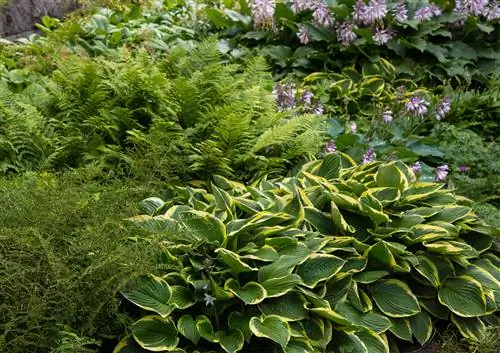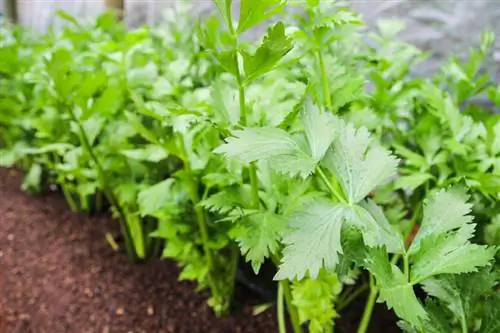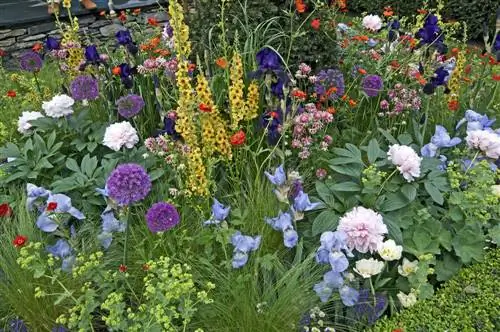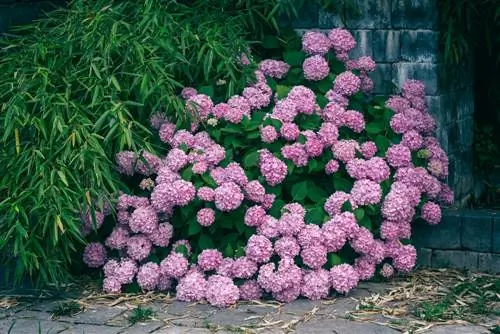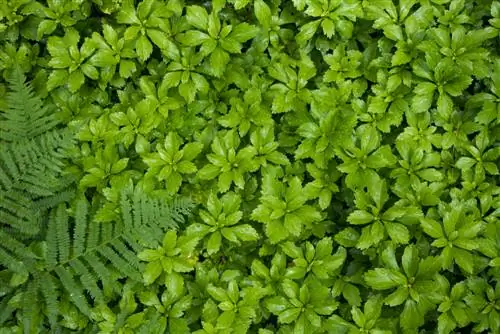- Author admin [email protected].
- Public 2023-12-16 16:46.
- Last modified 2025-06-01 06:02.
45 species and 4000 varieties - anyone planning to plant in containers or beds is spoiled for choice. But if you think that the hosta is difficult to combine because of its partially shaded or shady location, you are wrong. Flowering plants as a splash of color in the hosta bed, ferns as companion plants in the pot and grasses as a background. The hosta as an eye-catcher or as a ground cover. With the right selection, all combinations work.
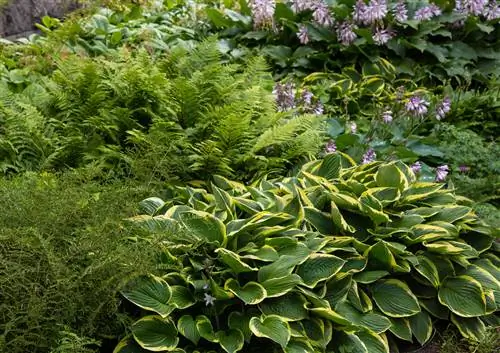
How to combine hostas?
Funkas can be combined with a variety of plants in semi-shady and shady locations. The selection ranges from shrubs and perennials to grasses and ground covers. Thanks to the large variety of colors and leaves, impressive arrangements can be created with just a few plants.
Location and substrate
Compared to many other garden plants, the hosta plant prefersshadytohalf-shady locations. With its large leaves, it can carry out sufficient photosynthesis despite the lower incidence of light. In nature, hostas are found primarily near the edges of forests. These locations also provide natural wind protection. If necessary, a few varieties can also be planted in sunny places. We have put together an overview of which species are suitable for planting here.

Planted closely and combined with each other, hostas can create a natural look.
The substrate should have asandytoloamy consistency. Sand and clay serve as drainage and ensure optimal water flow without the risk of waterlogging. In addition, a high proportion of humus is recommended. As with the basic choice of location, it is also advisable to focus on the natural conditions when laying out the beds. In addition to the properties mentioned above, forest soils are characterized by a high nutrient content and a moist and cool environment.
When planting with other perennials, ensure there is sufficientplant spacing. While a distance of 20 to 30 centimeters is sufficient for short-growing varieties, tall-growing species should have space of up to one meter. Therefore, pay attention to the information on height and width growth in the plant passport.
Combine hostas in the bed
Due to their different colors in flowers and leaves, hostas are ideal for combining different types of plants. An additional advantage of the foliage perennial is the different location conditions. This allows planting in almost any place. However, hostas are particularly popular for semi-shady to shady places where many other flowers thrive less than in the sun.
hosta bed in partial shade
Partially shaded locations are characterized by a maximum direct sunlight offour hours per day. During the rest of the day, the corresponding area is protected from sunlight by obstacles such as walls, hedges or bushes.

If you want to add color to a partially shaded bed, you can integrate daylilies into your bed planning.
Due to the limited lighting conditions, not all plant genera are suitable for planting. Hostas in particular, but also some other species, can also be combined well in partial shade.
Perennials and grasses for partial shade:
- Columbine
- Monkshood
- Japan grass
- Toad Lily
- Pipegrass
Shrubs for partial shade:
- Foxglove
- Bellflower
- Purple Bells
- Rhododendron
- Summer phlox
Ground cover for partial shade:
- Fat Man
- Elf Flower
- Günsel
- Silverbells
- Forget-me-not
Due to its late budding throughout the year, the hosta is particularly suitable for combining with early-flowering plants. The combination of plants that grow at different times makes it possible to create a bed that blooms all year round.
Planting example: Bed planting in partial shade
The combination of Iberian loosestrife, single-flowered pearl grass and dwarf hosta creates contrasts in shape, color and texture. The Iberian loosestrife with its white flowers forms the basis for the airy pearl grass, while the dwarf hosta with its round, shiny leaves forms the contrast. This combination is suitable for partially shaded locations.
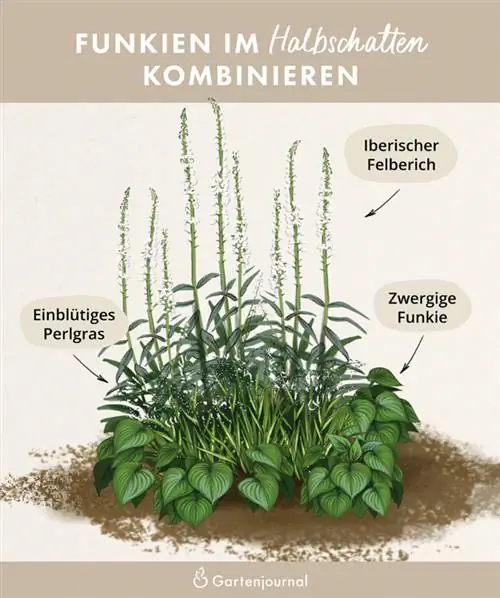
OtherCombination options with hostas in the partial shade bed are:
- Dwarf hosta, loosestrife and single-flowered pearl grass (see illustration)
- Funkie Crispula, Rhododendron Dramatic Dark and Azalea Bloom Champion
- Funkie Cherry Berry, viburnum hydrangea Incrediball and Bergenia David
- Funkie Liberty, tulips, daffodils and monkshood
hosta bed in the shade
Selecting suitable plants for shady locations is even more difficult than for partially shaded ones. Due to the maximum exposure time of three hours per day and the complete absence of midday sun, only a few plants can be planted here. In addition to the hostas, which naturally prefer shady locations, a variety of other genera such as shade grasses or perennials can now also be used.
Perennials and grasses for shade:
- Mountain sedge
- miscanthus
- Fuchsia
- Silver Candle
- Star Umbel
Shrubs for shade:
- Astilbe
- lily cluster
- Ranunculus
- Rib Fern
- Magic Haze
Ground cover for shade:
- Comfrey
- Memorial
- Hazelroot
- Lark Spur
- Snakebeard
Planting example: Bed planting in the shade
Oakleaf hydrangea, worm fern and white-edged hosta offer a balanced combination of flowers, foliage and texture. The oakleaf hydrangea has oakleaf-like leaves and conical inflorescences, the worm fern has delicate, dark green fronds and the white-edged hosta complements the combination with its upright, green, white-edged leaves. This combination is particularly suitable for shady locations and ensures a natural and elegant look in the bed.
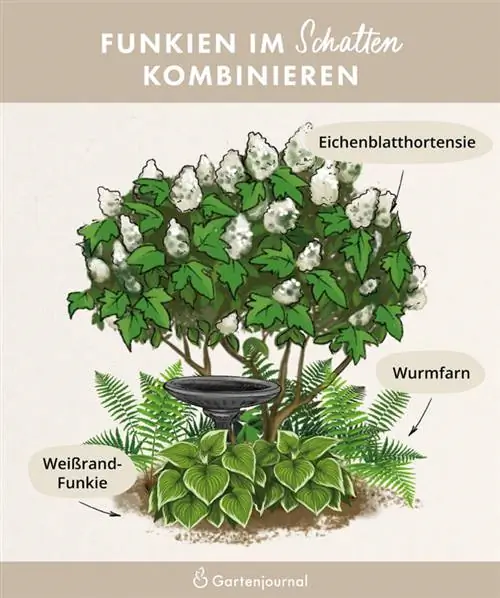
OtherCombination options with hostas in the shade bed are:
- Bell hosta, astilbe embers and local hazelroot
- Funkie August Moon, Rib Fern and Lungwort Rubra
- Funkie Praying Hands, Common Barberry and Spurge Fireglow
Combine hostas in the pot
small-sized species are particularly suitable for planting hostas in pots if they are to be combined. These remain of a manageable size both in terms of root growth and above ground. Due to their high light tolerance, many Hostas species are also suitable for otherwise difficult locations. Due to the low maintenance requirements, the foliage perennials are also ideal for beginners.
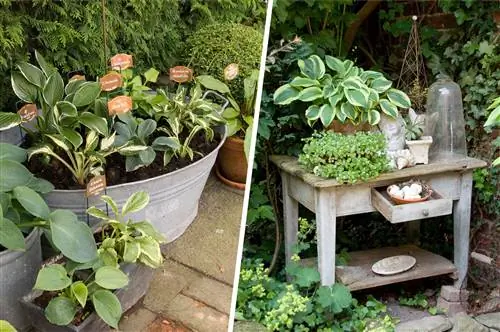
Due to the variety of species and varieties of hostas, they can also be combined with each other in a pot garden.
When choosing the right planter, the main thing to pay attention to is that it is of sufficient size. Even small varieties require a filling volume of at least five, preferably seven liters. This enables sufficient root penetration to provide the plant with sufficient stability and supply options. In principle, planting in balcony boxes is also suitable. However, only use mini hostas such as Cookie Crumbs, Country Mouse, Ice Cube, Kifkurin Ubatake or Little Devil.
When planting in pots, it is recommended to add a drainage layer. We have put together detailed instructions for the optimal setup here. This drains away excess water and thus prevents waterlogging, which is dangerous for almost all plants. In combination with a drainage hole on the bottom, your hosta will not be damaged. Further information on caring for potted plants can be found here.
Planting in containers in partial shade
A major advantage of container planting is the flexibility in choosing a location. Too much sunlight punishes the hostas by causing their impressive leaves to fade. Therefore, make sure that you do not expose your planted pots to too much light. If necessary, it is recommended to move the pots by hand or with a roller board, depending on their size and weight. Leaf burns are irreparable and can only be removed by cutting them off.
Perennials and grasses for partial shade
- Mountain grass
- Bitterroot
- Japanese harrow
- Ballbellflower
- Purple Bells
- Heron's Beak
- Silicate Gentian
- Storksbill
Due to their low growth height, some hosta species are also suitable for attractive table arrangements.
Planting example: pot planting in partial shade
The combination of Japanese rainbow fern, Caucasus forget-me-not and the hosta “Devon Green” harmonizes perfectly in a pot. The fern brings a fine texture and a copper-red color, the forget-me-not forms a backdrop for the other plants. The hosta complements the trio with deep green, shiny leaves. The bucket should have a capacity of at least 30 liters to provide enough space for all plants. A good arrangement is to place the largest plant in the center and arrange the smaller plants around it. This combination prefers a location in partial shade and is suitable for terraces and balconies.
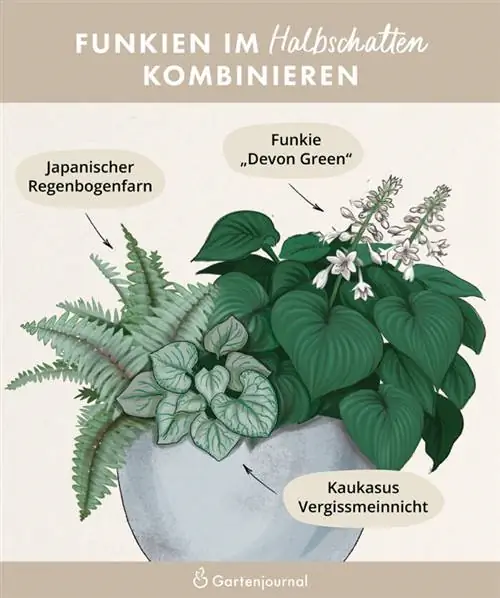
OtherCombination options for pots with hostas in partial shade are:
- Funkie Devon Green, Japanese rainbow fern and Caucasus forget-me-not (see illustration)
- Dwarf hosta, mountain grass and Japanese sedge
- Funkie Cherry Berry, Bluebell Caroline and Silicate Gentian
Planting in containers in the shade
While for many plants facing north there is not enough light, pot and box plants are ideal for this. Due to the usually weak lighting, the plants mentioned below thrive effortlessly compared to other plants.
Perennials and grasses for partial shade:
- Columbine
- Heucherella
- Oshima sedge
- Magnificent Piers
- Silverbells
- bleeding heart
- Spurweed
Such plant combinations are particularly popular as eye-catchers in front of the entrance door or on window sills.
Planting example: pot planting in the shade
The combination of hosta “Karossa Regal”, Caucasus forget-me-not “Mr. Morse”, dwarf peacock fern and white Balkan anemone are ideal for planting together in a container. The suitable bucket should have a filling volume of at least 40 to 50 liters (€29.00 on Amazon). Due to the different flowering times, the plants harmonize well with each other. The white Balkan anemone blooms from May to June, the Caucasus forget-me-not from April to May and the hosta “Karossa Regal” from July to August. The evergreen dwarf peacock fern brings structure to the combination all year round.
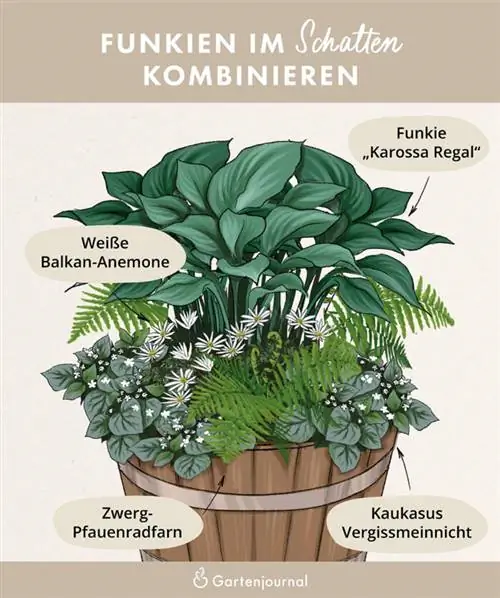
OtherCombination options with hostas for pots in the shade are:
- Funkie Karossa Regal, Caucasus forget-me-not, dwarf peacock fern and white Balkan anemone (see illustration)
- Funkie Barbara Ann, short-spurred columbine and silverbell obsidian
- Funkie Pilgrim, magnificent spire Rhineland and bleeding heart Aurora
FAQ
How to combine hostas?
In addition to perennials, grasses, shrubs and ground cover can also be used. Hydrangeas, star umbels, ferns, lily clusters, rhododendrons, foxgloves and phlox are suitable for the combination.
Which ground cover plants go well with hostas?
Suitable combination partners for partial shade are bergenia, fat man, elf flower, Günsel, silverbell, forget-me-not, vinca and Waldsteinia. For shady locations (less than three hours of sun per day), however, comfrey, comfrey, hazelwort, periwinkle, larkspur, lungwort, snake's beard and spurge are suitable.
What planting distance do hostas need?
Small varieties only need a planting distance of 20 to 30 centimeters. Large-growing varieties require a distance of up to one meter from their companion plants.
Where can hostas be planted?
Hostas prefer semi-shady and shady locations. They are generally exposed to less competition here, but can absorb even the smallest amounts of light due to their large number of leaves.

